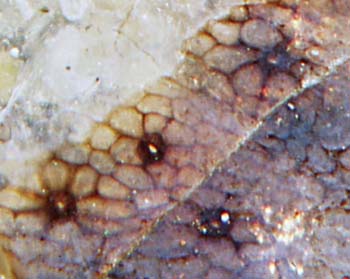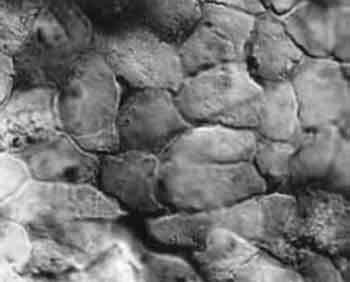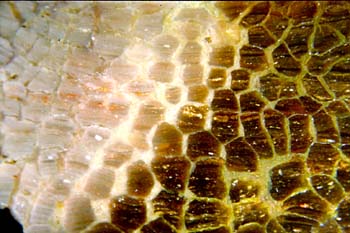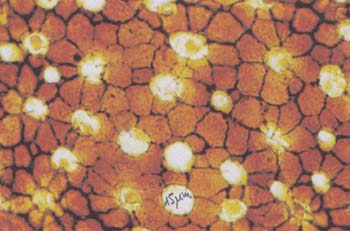Fossil polygon patterns - confusing and revealing
This display of fossil network-like patterns of quite
different origin is meant as a warning not to lightsomely misinterpret
polygonal meshes as plant cells as it has been done
repeatedly in
palaeobotany. Among the patterns seen here, only one shows cells. Three
of them
are crack patterns in silicified peat, without any relation to the
peat texture. The remaining three are related to nematophytes
in different
ways, which makes them relevant for solving the problem of where to
place these enigmatic organisms on the tree of life.

Fig.1: Epidermis with stomata, well visible in the incident
light
reflected
from the slanting crack face below,
Asteroxylon, Lower
Devonian, Rhynie chert.
Fig.2: Nematophyte in Rhynie chert,
apparently consisting of parallel tubes with thick coatings of gel,
width of
the picture 0.7mm.
Fig.3: Enigmatic "Nematothallus
cuticle", often found
together with carbonaceous nematophyte compressions,
width
of the picture 0.05mm.
Figs.4,5,7: mm-size polyhedra and polygonal columns in
silicified
peat, seen as polygonal networks on the cut face,
Lower
Permian, Döhlen basin, Germany.
Fig.6: "Cosmochlaina
cuticle" [1], interpreted as a crack
pattern here.
Apparently the sample in Fig.2 is the only one found hitherto which
leads the way to an understanding of both Nematothallus
(Fig.3)
and Cosmochlaina
(Fig.6), the Silurian /Lower Devonian cuticles whose attempted
interpretations as being related to the epidermis of some plant had
been in vain. Although the patterns in Fig.3 and
Fig.6 are
quite different, there are reasons to assume that both are replicas of
shrinkage crack patterns on the surface of a lump of organic gel
harbouring the tubular structure of a nematophyte.
Obviously the pattern in Fig.6, unlike the one in Fig.3, does not
follow
the boundaries of the gel
coats squeezed into more or less polygonal columns as in Fig.2 but
resembles the polygonal cracks in Figs.4,5,7 instead.
The irregular polyhedra in Figs.4,5,7 may be elongated, with length
/diameter ratios exceeding 20, and thus can be considered analogous to
the well-known big basalt columns [5].
The
present interpretation of Fig.6 contradicts a recent interpretation as
the lower epidermis of a hypothetical ancient liverwort [2], thereby
refuting the
hypothesis by Graham
et al. [3] which reduces Prototaxites
to a
liverwort carpet roll.
Addendum 2016:
The above
images, of course, represent only a small fraction of polygonal or
polyhedral patterns encountered in connection with fossils. Polygons of
biological origin are the less problematic ones: When individual
globular cells join, in the course of evolution, to make a tightly knit
tissue, they necessarily become polyhedral, as they are in the tissue
of land plants (Fig.1). Even more easily understood are aligned coated
cylinders whose coatings become squeezed into columns with polygonal
cross-section, as in Fig.2.
More problematic are the polygons
and polyhedra formed by propagating cracks. Since crack propagation is
governed by fracture mechanics, one might expect mechanics to provide
easy explanations. It has turned out, however, that only simplified
model crack configurations can be shown to develop along the lines of
fracture mechanics into networks of regular meshes. The extension of
such results to more real situations, as here in Figs.4-7, may be
called justified guesswork.
Samples: Figs.1,2,4,5: own finds, Fig.1: photograph by H. Sahm;
Fig.3: photograph by H.
Kerp,
in [4].
Fig.7: found and photographed by Wolfgang Schwarz.
H.-J.
Weiss
2012
completed 2014
[1] D.
Edwards:
Dispersed cuticles of putative non-vascular plants from the Lower
Devonian of Britain,
Bot. J. Linnean Soc.
93(1986), 259-75.
[2]
L.E. Graham,
L.W. Wilcox, M.E. Cook, P.G. Gensel:
Resistant tissues of
modern marchantoid liverworts resemble enigmatic Early Paleozoic
microfossils.
Proc. Nat. Acad.
Sci., USA, 101(2004), 11025-29.
[3] L.E.
Graham,
M.E. Cook, D.T. Hanson, K.B. Pigg, J.M. Graham :
Structural, physiological, and
stable carbon isotope
evidence that the enigmatic Paleozoic fossil Prototaxites formed
from rolled liverwort mats.
Am. J. Bot. 97(2010), 268-275.
[4] H.
Steur, W.v.d. Brugghen:
Grondboor & Hamer (1998), 28-35.
[5] M. Hofmann et al.: Why hexagonal basalt columns ? Phys. Rev. Lett. 115, 154301 (2015).












